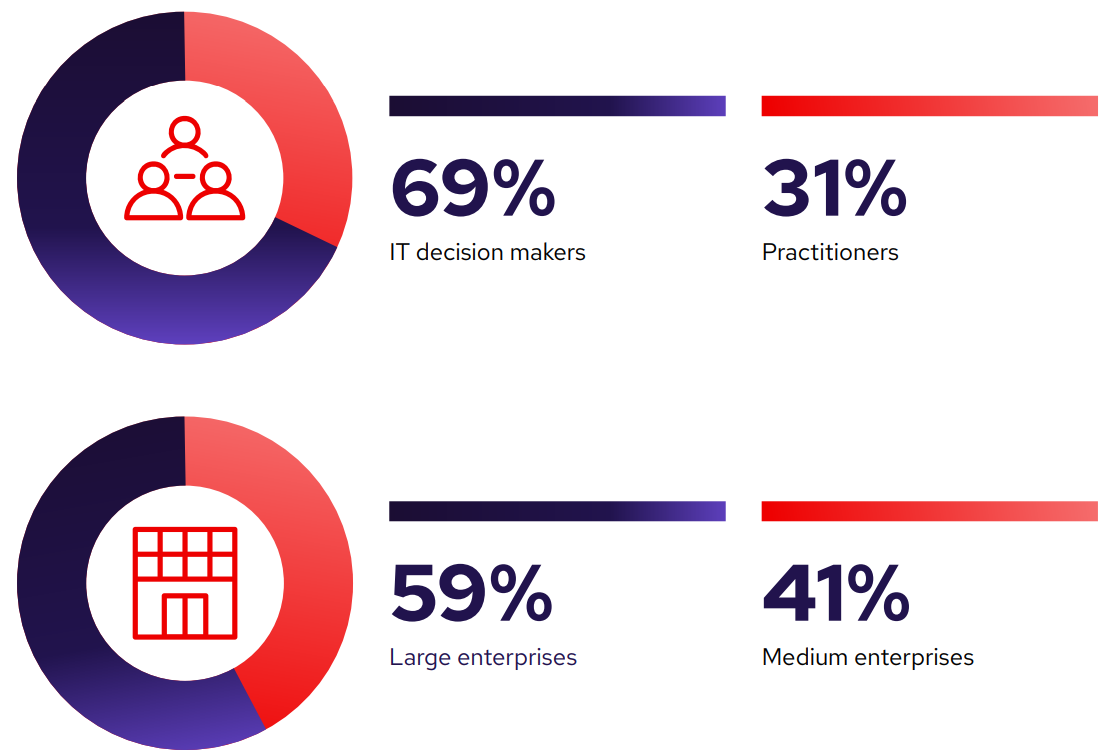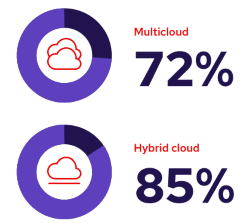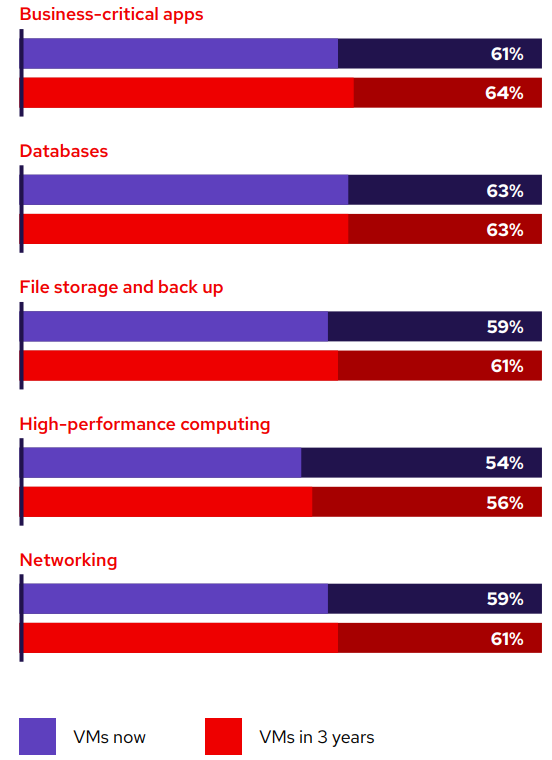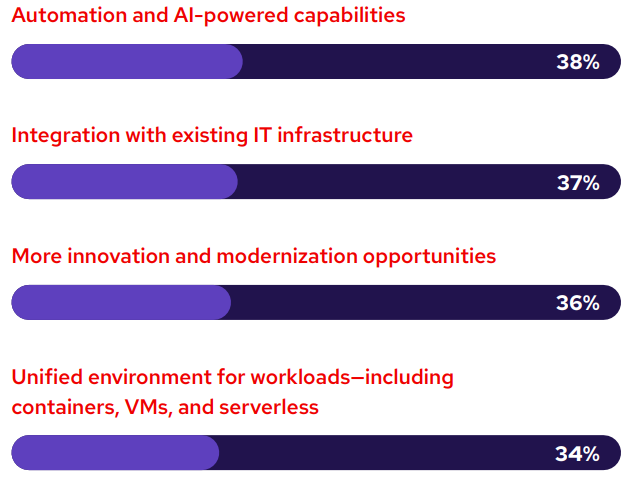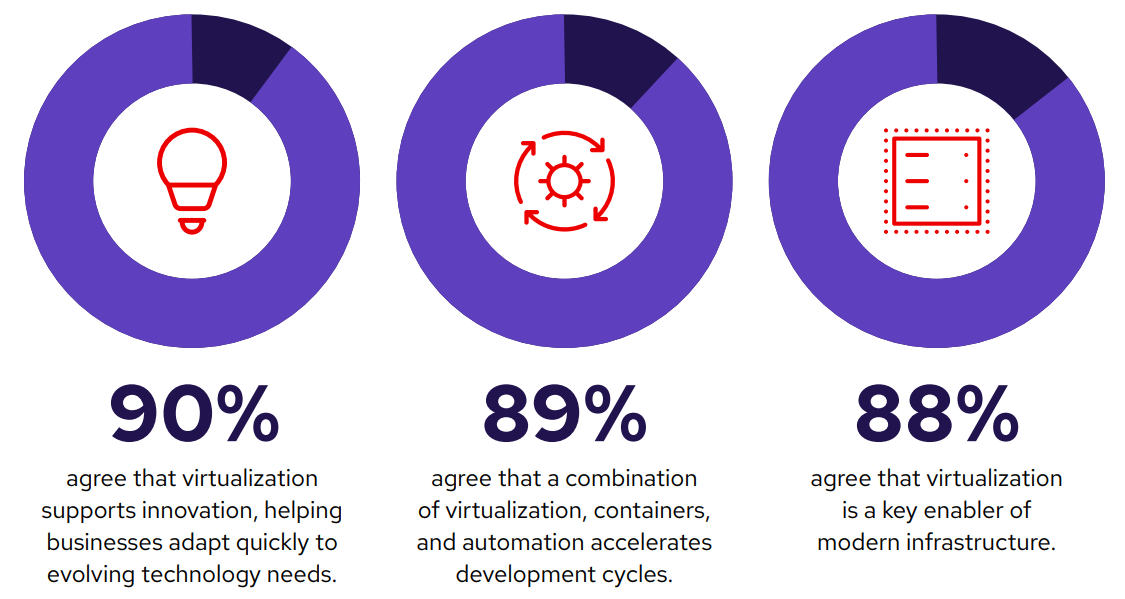The state of virtualization
Introduction
For more than 20 years, businesses have widely adopted virtualization as a way to improve how they manage IT resources.
Virtualization initially gained momentum as organizations looked for ways to consolidate servers, lower power and cooling needs, and create more flexible environments for their applications. By allowing multiple operating systems and applications to run on the same physical hardware, virtualization has helped companies reduce costs, streamline operations, and get more value from their existing infrastructure.
Traditional virtualization technology uses a lightweight ‘hypervisor’ installed directly on top of a server to abstract its physical resources (typically compute, network, and storage) so they can be accessed through software. This offers an incredibly efficient alternative to traditional processes, which is why virtualization quickly became a core part of modern datacenters and laid the groundwork for many cloud technologies that businesses rely on today.
The research in this e-book shows that choice of where and how to run workloads continues to be top of mind for customers. While virtual machines (VMs) are expected to retain their position as a significant technology in IT far into the future, a large number of organizations are also reporting that cloud-native architectures (including containerized applications) are becoming increasingly important to their operations.
This shift towards cloud-native architecture and containerized workloads means that many IT teams are expected to operate VMs and containers simultaneously. Because VMs and containers were introduced to solve different IT challenges and meet diverse application requirements, each satisfies unique needs.
VMs provide value through resource isolation, security isolation, and operating system (OS) management at scale, and containers offer lightweight technologies to deliver developer agility, application portability, and operational efficiency. Because organizations can stand to benefit from both technologies being used in tandem, many are trying to make difficult decisions about their application portfolio.
The combination of these developing trends—as well as major shifts in the virtualization vendor landscape that sparked concerns within organizations about their virtualization platform—means many are reassessing their existing platform capabilities and looking for a solution that can support both their current and future needs.
In this e-book, we will delve into data from the inaugural Red Hat®-sponsored virtualization survey, conducted by Illuminas. This data provides insights into how organizations are currently using and planning to use virtualization in the future, common concerns about existing virtualization platforms, evolving virtualization platform needs, the complexity of virtualization migrations, and how virtualization is expected to play a role in the future of innovation.
Chapter 1: About this report
Red Hat sponsored a survey conducted by Illuminas of 1,010 IT decision makers (ITDMs) and virtualization practitioners in the United States (U.S.), the United Kingdom (U.K.), and the English-speaking Asia Pacific region (APAC) to uncover existing pain points with current virtualization platforms, to identify key barriers hindering migration to alternative platforms, and to determine what successful virtualization looks like for the future. Red Hat, in collaboration with Illuminas, gathered and analyzed data through 15-minute online interviews with respondents sourced from third-party databases. The survey was conducted in March and April of 2025.
Respondent profiles:
- ITDMs and practitioners at enterprise organizations responsible for their organization’s virtualized infrastructure.
- ITDMs were defined as directors and above who are responsible for virtualization strategy, planning, and oversight, with influence or responsibility for purchasing decisions related to virtualization infrastructure solutions.
- Practitioners were defined as managers and above who are responsible for the day-to-day management, maintenance, and operation of their organization’s virtualized environment.
Chapter 2: Key findings and insights
Our survey generated rich insight into how organizations currently approach virtualization, as well as their future virtualization plans, including key findings such as:
72% of organizations are using multiple clouds.
85% of organizations are using a hybrid cloud model.
71% of organizations have more than half of their IT infrastructure virtualized.
Organizations have fully achieved/exceeded a range of virtualization benefits, including:
Organizations are looking for a range of capabilities in a new virtualization platform, including:
Today, organizations are deploying workloads in a mix of traditional VMs (61%) and containers (38%). In the next 3 years, use of traditional VMs is expected to remain relatively the same (60%), while containers are expected to rise in use (45%).
43% of organizations are very/extremely likely to switch to a different or additional hypervisor in the next 3 years.
70% of organizations have recently moved VM workloads to a different or additional hypervisor—or are in the process of making a switch.
90% of organizations agree that virtualization supports innovation, helping businesses adapt quickly to evolving technology needs.
Organizations’ top changes to virtualization strategies in the next 3 years include:
Insight #1: Enterprise IT is cloud-powered and virtualized
Nearly all respondents use hybrid and multicloud environments.
This research shows that 72% of organizations are using multiple clouds and 85% of organizations are using a hybrid cloud model. This highlights the diverse infrastructure that is often being simultaneously managed within an organization’s IT landscape, and suggests a desire for interoperability between clouds for efficiency. Additionally, to maintain a competitive edge, organizations are optimizing for hybrid, virtualized infrastructure. Virtualized workloads are being run in a large variety of environments, including a mix of cloud providers and on-premise datacenters. This growing diversity of where virtualized workloads are being run highlights the need for hybrid cloud solutions that can deliver standardized operations and streamlined management across hybrid and multicloud environments.
Alongside private clouds, organizations are running virtualized workloads in a variety of environments across public clouds:
Surveyed organizations’ current cloud infrastructure includes:
Majority of organizations have over half of their IT infrastructure virtualized.
Respondents confirm that a large majority of their IT infrastructure is virtualized, with a wide variety of virtualization technologies being used. Server virtualization is widely adopted and well-established, with 84% of organizations citing its use. Additional types of virtualization, including storage (81%) and network (77%) virtualization, are also highly adopted amongst organizations, as they allow for increased agility and control of the abstracted physical stack through software.
This trend shows that organizations are recognizing that every part of their IT, from hardware to user interface, can be virtualized and modernized, and highlights the versatility and effectiveness of virtualization, even as needs and technologies evolve.
of organizations have over half of their IT infrastructure virtualized.
Insight #2: Common concerns prompt reassessment of existing virtualization platforms
Top concerns include licensing costs, management complexity, and vendor lock-in.
We asked respondents to identify their top concerns with their existing virtualization platform. Responses were scattered across a variety of factors for all organizations, with 1 in every 3 respondents reporting that licensing costs and management complexity were a top concern with their existing virtualization platforms. This could stem from many factors, including vendor licensing changes, pricing increases, diverse applications and environments with inconsistent tools, and outdated software. Continued support of existing platform (27%) and confidence in long-term vision (24%) were also cited as top concerns, suggesting distrust with existing virtualization platforms.
Common concerns with existing virtualization platforms:
Insight #3: Virtualization is here to stay, but platform needs are evolving
Two out of 3 organizations reported fully achieving or surpassing their virtualization goals across a range of operational benefits.
We asked respondents to identify the extent to which their organization has fully achieved or exceeded specific virtualization benefits. Overall, organizations are pleased with the outcomes virtualization can deliver across various use cases. Enablement of cloud strategy (72%), improved disaster recovery (72%), and reduction in hardware dependency (68%) were some key identified benefits.
This shows the continued value of virtualization in today’s technology stack to simplify and strengthen business operations, and shows why virtualization usage, alongside containers, is increasing or at least remaining steady in many key workloads, including business-critical applications, databases, file storage and backup, high-performance computing, and networking.
Virtualization benefits fully achieved/exceeded:
VM usage now vs. expected usage in 3 years:
Despite these successes, virtualization platform needs are evolving.
The continued effectiveness of virtualization within modern IT strategies is clear, but many organizations’ virtualization needs are evolving to support expanding requirements. This shift is the result of many key factors, including the push for automation and AI-powered capabilities (38%), the need for integration with existing IT infrastructure (37%), the desire for more innovation and modernization opportunities (36%), and a more unified environment for diverse workloads (34%).
These factors suggest the need for a future platform to support growing business demands and avoid disruption across the existing ecosystem. Many organizations require a virtualization platform that can plug into their existing environments and evolve with them by providing modern, innovative, and automated capabilities.
Top considerations organizations are looking for in a new virtualization platform:
Respondents expect to continue deploying virtualized workloads alongside containers.
We wanted to explore the ways in which organizations believe their consumption of virtualization and containerization is changing over time. The research shows that virtualization usage is expected to remain relatively consistent, as VMs will continue to serve as the backbone of many current IT environments. And yet, container adoption is also expected to rise across a range of workloads in the next couple of years.
To reduce operational inefficiencies around the management and cost of maintaining both virtualization and container-based platforms, many organizations are looking for a unified platform that can support both VMs and containers—with the option to apply modern application development and delivery methodologies where they see fit—as container workloads are expected to rise 7% in the next 3 years.
How organizations are deploying workloads today:
How organizations expect to deploy workloads in the next 3 years:
Insight #4: Workload migration is inevitable, but it’s not always a smooth journey
Survey results show a clear desire for a change in platform strategy.
A majority of organizations surveyed note that they are likely to switch to a different hypervisor platform in the next 3 years, with 43% reporting that they are very/extremely likely, and 33% reporting that they are somewhat likely. As previously noted, concerns with existing virtualization platforms span a wide variety of challenges including licensing costs, management complexity, and more (see insight #2).
Workload migration intent is strong, but execution can be slow.
This survey data shows that a majority of organizations have experienced, or expect to experience, lengthy migrations of over a year or longer, with workload complexity (34%) and timing for testing and validation (34%) standing as top challenges. This means that the sooner organizations can start planning for a hypervisor migration onto a platform that can execute efficient migrations, the greater effectiveness they can expect.
Organizations’ existing/expected timeline for workload migration:
Most common barriers to achieving migration within the expected timeframe:
of organizations expect/experienced a workload migration of over a year.
of organizations have recently moved VM workloads to a different or additional hypervisor—or are in the process of making a switch.
Insight #5: The future of IT embraces complexity and diversity
Nearly all respondents view virtualization as a key enabler of productivity and innovation in their organizations.
This survey shows that almost all organizations value virtualization for its ability to support innovation, including adapting to evolving technology needs and managing modern infrastructure. Alongside the continued shift toward virtualization across hybrid and multicloud environments, and the increased adoption of container-based workloads, most organizations see virtualization as a key contributor towards an innovative future.
Organizations are diversifying their environments and workloads.
This survey reports that many organizations will continue to diversify their environments, with a steady push towards containers and a modernized infrastructure. This shift is most likely the result of the need for greater flexibility, scalability, and efficiency when deploying a mix of applications and complex AI models.
Because containers offer a lightweight, portable option across environments with the ability to support advanced workloads through modern integrations, it is not surprising that more organizations are expanding their adoption of containers and modern development practices and investing in automation tools. Many respondents indicated a growing interest in unified platforms to manage increasingly diverse workloads across hybrid and multicloud environments.
Organizations’ top changes to virtualization strategies in the next 3 years:
Respondents reported that generative AI will be a key contributor to the future of virtualization management and operations.
With virtualized workloads running in increasingly diverse environments, generative AI (gen AI), will play a key role in helping to simplify operations and management. With nearly all surveyed organizations exploring gen AI, it is a critical aspect of the future of virtualization management that we expect to continue to grow.
How organizations are using or exploring gen AI in virtualization management:
Chapter 3: Start your virtualization journey with Red Hat
Red Hat’s trusted products, partner ecosystem, and open source foundation come together to offer you flexible options that suit your virtualization needs.
At the core of our virtualization solutions, Red Hat OpenShift® Virtualization—a feature of our trusted, comprehensive, and consistent platform, Red Hat OpenShift—offers a unified, scalable platform for migrating and managing VMs alongside containerized workloads. It provides consistent management across hybrid cloud environments and supports modernization efforts so your organization can efficiently manage and deploy VMs, containers, and serverless workloads with a comprehensive set of development and operations tools.
Migrate VMs to a platform that grows with you
With Red Hat, you can preserve your existing virtualization investments while preparing for the future. Migrate your VMs to Red Hat OpenShift with embedded, user-friendly migration tools and save on infrastructure costs through a streamlined virtualization solution.
Red Hat OpenShift Virtualization Engine, a dedicated virtualization edition of Red Hat OpenShift, provides a streamlined, cost-effective option to deploy and manage your VMs, while offering a smooth path to modernize with the broader Red Hat OpenShift portfolio—if and when needed. As VMs remain a critical tool in IT infrastructure, OpenShift Virtualization Engine offers a dedicated and security-focused approach to VM management to meet users where they are in their virtualization journey.
Red Hat Consulting offers a Virtual Migration Assessment to help organizations kickstart VM migration planning by analyzing both infrastructure and workload complexities to build an actionable migration plan. A Total Economic Impact™ study conducted by Forrester Consulting stated, customers who used Red Hat Consulting experienced 46% faster implementation time1 of Red Hat OpenShift and the migration of their virtual machines.
To extend its value, OpenShift Virtualization Engine integrates with the Red Hat portfolio to deliver a complete automation and management solution. With Red Hat Ansible® Automation Platform, you can automate VM migration at scale, as well as ongoing management of related infrastructure. Through Red Hat Advanced Cluster Management for Virtualization, organizations can access a centralized and compliant management platform for everything from provisioning and performance monitoring to decommissioning VMs.
Manage your applications consistently, anywhere
Managing applications across a variety of environments can be complex. That’s why Red Hat OpenShift Virtualization provides a single, consistent view and operational model to manage your application workloads across various environments.
OpenShift Virtualization supports self-managed physical servers in datacenters, edge environments, and public cloud environments, so you can choose the optimal infrastructure for your VMs, containers, and serverless workloads. OpenShift Virtualization is continuing to expand across all major cloud providers, including Google Cloud, Microsoft Azure, IBM Cloud, and Oracle Cloud. It is also available as part of Red Hat OpenShift Service on AWS—a fully managed cloud service—to help you offload ongoing platform management and get started in less time.
With OpenShift Virtualization, teams can access a connected management experience across target environments when running their various workloads, improving efficiency and resource utilization.
Learn how to migrate your VMs more quickly and safely with the Virtualization Migration Assessment from Red Hat Consulting
Modernize and innovate for the future
Red Hat’s virtualization solution allows you to keep your options open. Through the broader Red Hat OpenShift portfolio, organizations can efficiently manage VMs alongside containers and serverless workloads on a single, unified platform.
Red Hat OpenShift offers options to take advantage of modern capabilities, such as cloud-native application development, DevOps, and continuous integration and continuous delivery (CI/CD) practices, with OpenShift Container Platform and OpenShift Platform Plus.
The Red Hat OpenShift portfolio also helps you access the value of gen AI through Red Hat OpenShift Lightspeed. This virtual assistant for Red Hat OpenShift can answer virtualization-specific questions to help simplify your VM management and modernization efforts even further.
Chapter 4: Resources and information
E-book: 15 reasons to adopt Red Hat OpenShift Virtualization
Discover 15 reasons for adopting OpenShift Virtualization and learn how it can help improve system reliability incidents and developer productivity.
Overview: Red Hat OpenShift Virtualization Engine
Learn how OpenShift Virtualization Engine can provide an alternative platform to host VMs and help satisfy immediate VM requirements in a cost-effective way.
E:book: 15 reasons to migrate virtual machines to Red Hat OpenShift Service on AWS
Read how Red OpenShift Service on AWS can help you reduce support costs and increase operational efficiency while freeing IT teams to focus on innovation.
E-book: The value of Red Hat OpenShift Virtualization partner ecosystem
Learn how OpenShift Virtualization, alongside a large ecosystem of ISV partners, provides a path to infrastructure modernization and streamlined migration.
E-book: Get started With Red Hat OpenShift Virtualization
Explore common tasks that you can perform with OpenShift Virtualization and step-by-step guidance for using OpenShift Virtualization.
Interactive OpenShift Virtualization demos
Try these step-by-step scenarios for guidance through the fundamentals of using OpenShift Virtualizations, including migration, management, and more.
Trial: Try OpenShift Virtualization today
Explore a 60-day trial of Red Hat OpenShift Virtualization Engine to see how to deploy, manage, and migrate virtual machines on a platform that grows with you.
Overview: Simplify your VM migration to Red Hat OpenShift Virtualization
Accelerate the migration of traditional VMs to a scalable, modern infrastructure platform through a rapid approach that mitigates risk.
Take the first step in your migration journey with the Virtualization Migration Assessment, offered by Red Hat Consulting.
Forrester Consulting study, commissioned by Red Hat. “The Total Economic Impact™ Of Red Hat Consulting For OpenShift.” 2024.

